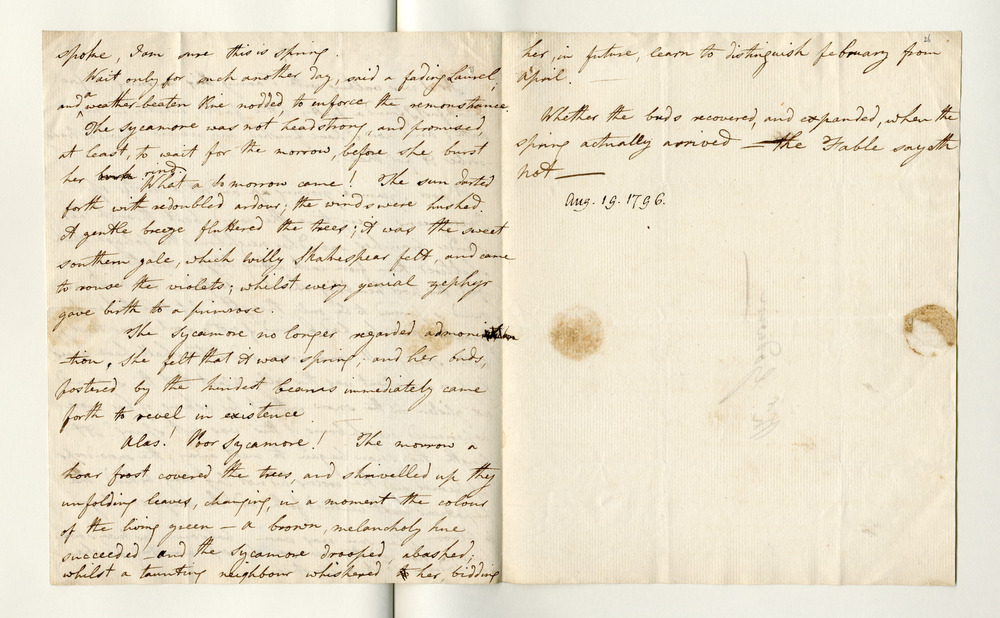Letter to William Godwin

This Treasure is paired with: Fontaine’s Le jeu des fables (Fables)
Mary Wollstonecraft was a philosopher and feminist, and author of A Vindication of the Rights of Woman (1792). Her relationship with the radical philosopher William Godwin is brought to life through their letters. In this one, at the start of their romantic involvement, Mary shows her vulnerability after a previous disastrous relationship. She composes a fable of herself as a bare sycamore tree, longing for spring, which buds too soon and shrivels in a frost. Although Godwin read this cry for warmth as a criticism and a desire to separate, they married some months later.
Transcription
As I was walking with Fanny this morning, before
breakfast, I found a pretty little fable, directly in my
path; and, now I have finished my review, I will tran-
scribe it for thee.
A poor Sycamore growing up amidst a cluster of
Ever-greens, every time the wind beat through her
slender branches, envied her neighbours the foliage which
sheltered them from each cutting blast. And the only com-
fort this poor trembling shrub could find in her mind (as
mind is proved to be only thought*, let it be taken for
granted that she had a mind, if not a soul) was to say,
well; spring will come soon, and I too shall have leaves.
But so impatient was this silly plant that the sun could
not glisten on the snow without her asking, of her more
experienced neighbours, if this was not spring? At
length the snow began to melt away, the snow-drops
appeared, and the crocus did not lag long behind, the
hepaticas next ventured forth, and the mezereon began
to bloom.
The sun was warm – balsamic as May’s own
beams. Now said the sycamore, her sap mounting, as she
[*] see Godwin’s Political Justice
[fol. 25v]
spoke, I am sure this is spring.
Wait only for such another day, said a fading Laurel;
and a weather-beaten Pine nodded, to enforce the
remonstrance.
The Sycamore was not headstrong, and promised,
at least, to wait for the morrow, before she burst her rind.
What a to morrow came! The sun darted
forth with redoubled ardour; the winds were hushed.
A gentle breeze fluttered the trees; it was the sweet
southern gale, which Willy Shakespear felt, and came
to rouse the violets; whilst every genial zephyr
gave birth to a primrose.
The Sycamore no longer regarded admoni-
tion, she felt that it was spring; and her buds,
fostered by the kindest beams immediately came
forth to revel in existence.
Alas! Poor Sycamore! The morrow a
hoar frost covered the trees, and shrivelled up thy
unfolding leaves, changing, in a moment the colour
of the living green – a brown, melancholy hue
succeeded – and the sycamore drooped, abashed;
whilst a taunting neighbour whispered her, bidding
[fol. 26r]
her, in future, learn to distinguish february from
April.
Whether the buds recovered, and expanded, when the
spring actually arrived – the Fable sayeth
not –
This Treasure isn’t currently on display in the Weston Library.


